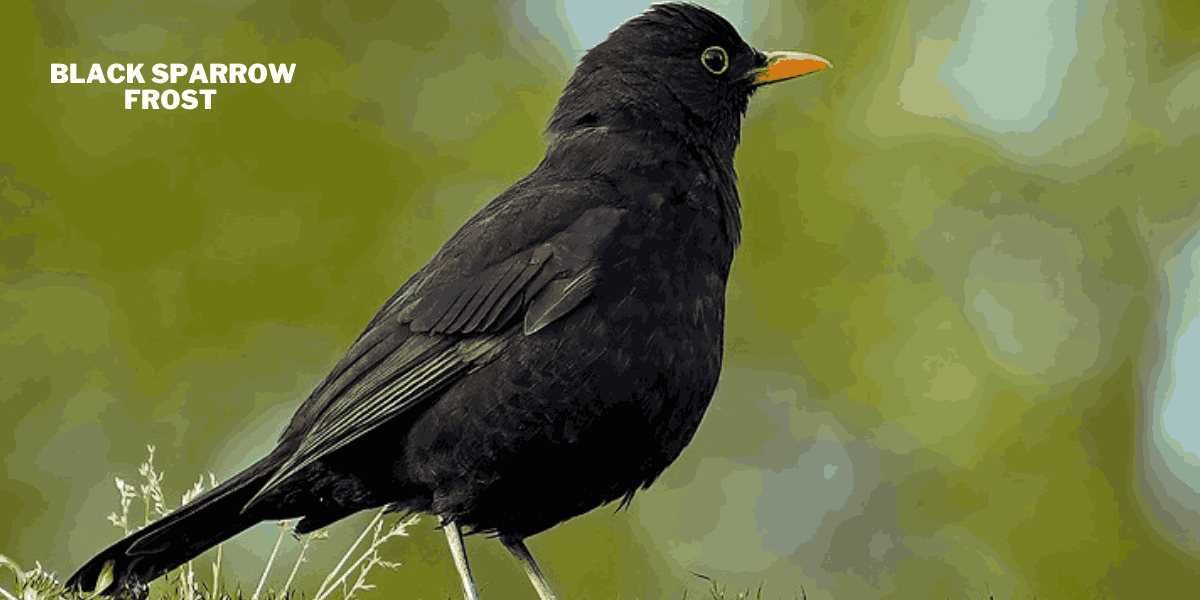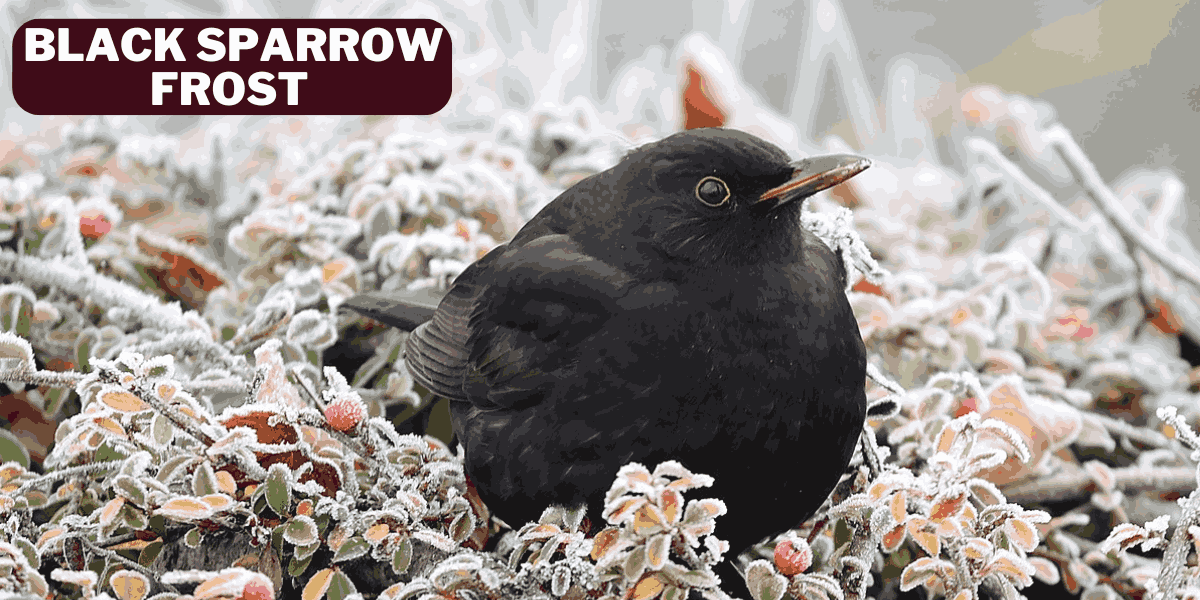Black sparrow frost: Uncover the secrets of the black sparrow! Explore their winter adaptations, behavior, and how they thrive in frosty landscapes. Learn how to attract them to your backyard!
Introduction
As winter tightens its grip, a flurry of activity fills the bare branches. Amongst the robins and chickadees, a sleek, jet-black bird stands out—the black sparrow. While their brown cousins might struggle, black sparrows appear unfazed by the frost. But how do these seemingly ordinary birds survive the harshest conditions? This article delves into the fascinating world of black sparrows, exploring their remarkable adaptations, winter behavior, and tips to attract them to your own backyard.
Black Sparrow: A Bird of Many Names
The black sparrow, also known as the Eurasian Tree Sparrow or simply the blackbird (though not to be confused with the American Robin, often called a blackbird), is a small but resilient bird native to Europe and Asia. These sparrows boast a sleek, black plumage, contrasting with a white chest and chestnut wing bars. They are known for their cheerful chirping and social nature, often forming large flocks in winter. Despite their abundance, black sparrows remain slightly enigmatic, with much to be discovered about their specific winter survival strategies.
Winter Warriors: black sparrow frost‘s Remarkable Adaptations

Winter presents a multitude of challenges for birds. Food becomes scarce, water sources freeze, and brutal temperatures threaten survival. But black sparrows possess a unique set of adaptations that allow them to thrive in these harsh conditions:
Dense Plumage: Unlike their brown sparrow counterparts, black sparrows have a thicker, denser plumage that provides superior insulation. This layer of feathers acts as a barrier against the biting cold, allowing them to retain precious body heat.
Cooperative Roosting: Black sparrows demonstrate remarkable social behaviour during winter. They huddle together at night in communal roosts, often within cavities or dense vegetation. This huddling behaviour not only conserves individual body heat but also creates a warmer microclimate within the roost.
Foraging Prowess: Winter brings a scarcity of insects, so black sparrows adapt their diet. They become adept at finding seeds buried beneath the snow or hidden in cracks and crevices. Their strong beaks are well-suited for cracking open hard seeds, providing them with valuable nutrients during the cold months.
Internal Adjustments: Black sparrows undergo physiological changes in response to winter. Their metabolic rate increases slightly, allowing them to burn more energy to generate heat. Additionally, their bodies can store more fat reserves before winter arrives, providing a readily available source of energy for extended periods without food.
Beyond Survival: Black Sparrows’ Winter Behaviour
Black sparrows are not simply enduring the winter months; they are actively thriving. Here’s a glimpse into their fascinating winter behaviour:
Communal Foraging: Black sparrows often forage in large flocks during winter. This cooperative behaviour allows them to find food sources more efficiently and reduces the risk of predation by individual birds. The presence of multiple birds also helps to scare away potential predators.
Vocal Communication: Black sparrows rely heavily on vocal communication throughout the year. They use a variety of chirps, whistles, and calls to stay in contact with each other, especially when foraging as a flock. These vocalisations help maintain group cohesion and warn of potential threats.
Courtship and Nesting: While breeding typically occurs in spring and summer, some black sparrows might exhibit courtship behaviour even during winter. This early preparation allows them to claim nesting territories and begin breeding as soon as the weather warms.
Attracting Black Sparrows to Your Winter Wonderland
These fascinating birds can be a welcome addition to your winter backyard. Here’s what you can do to attract black sparrows:
Provide Food Sources: Offer a variety of birdseed options, including black oil sunflower seeds, nyjer seeds, and millet. Scatter seeds on a platform feeder or in a ground feeder to cater to their diverse foraging preferences. Suet blocks can also be a great source of high-energy fat reserves during winter.
Offer Shelter: Provide a safe haven from harsh weather by building or purchasing a sturdy birdhouse with a small entrance hole. Choose a location protected from wind and predators
The Black Sparrow in Folklore and Mythology
Black sparrows hold a significant place in various cultures around the world. In some traditions, they symbolise resilience, adaptability, and resourcefulness – qualities they demonstrably possess in winter. In Chinese folklore, the black sparrow is associated with longevity and good fortune. In contrast, some European myths depict black sparrows as harbingers of bad luck or misfortune. Regardless of the specific interpretations, the black sparrow’s unique appearance and winter survival skills have undoubtedly captured the human imagination for centuries. [Consider adding an internal link to an article about “Bird Symbolism” here]
Conservation Efforts and Threats
While black sparrows are currently a widespread species, habitat loss and changes in agricultural practices pose potential threats. The conversion of natural areas into farmland can limit nesting sites and food sources. Additionally, the use of pesticides can disrupt the insect populations that black sparrows rely on during the summer months. Conservation efforts focus on preserving natural habitats and promoting sustainable agricultural practices. By creating a balance between human activities and the needs of wildlife, we can ensure the continued survival of these remarkable winter warriors.
Conclusion
The black sparrow stands as a testament to the power of adaptation in the natural world. Their remarkable winter survival strategies – from their dense plumage to their cooperative behaviour – allow them to thrive in harsh conditions. By attracting black sparrows to our backyards and supporting conservation efforts, we can ensure these feathered enigmas continue to grace our winter landscapes for generations to come.
Faq
- What is the name of black sparrow?
Black-chinned Sparrow (Spizella atrogularis), version 2.0. In The Birds of North America (P. G. Rodewald, editor). Cornell Lab of Ornithology, Ithaca, New York, USA.
- What is the diet of a black sparrow?
Food. Black-throated Sparrows are primarily ground foragers, foraging near or under shrubs and cacti. They also glean food from leaves and twigs in shrubs. They mainly eat insects during the breeding season and seeds during the nonbreeding season.
- Who is female sparrow?
Male House Sparrows are brightly colored birds with gray heads, white cheeks, a black bib, and rufous neck – although in cities you may see some that are dull and grubby. Females are a plain buffy-brown overall with dingy gray-brown underparts. Their backs are noticeably striped with buff, black, and brown.
- When a sparrow comes in your house?
Protection and Good Luck: In some cultures, sparrows are considered symbols of protection and good luck. Their visit could be interpreted as a sign that you’re being watched over or that positive things are coming your way.
- What is the rarest type of sparrow?
One of North America’s Most Endangered Birds
The Florida grasshopper sparrow (Ammodramus savannarum floridanus), the rarest bird in North America, is a non-migratory subspecies found only in the dry prairies of south-central Florida.
- Are sparrows intelligent?
Do sparrows eat egg?
In captivity, you can feed your parrot some boiled chicken egg on a regular basis. Goose, duck and other egg types are also fine. It shouldn’t be part of your bird’s daily diet – which should consist of complete parrot pellet food and plenty of fresh vegetables – but it can make a great weekly addition.
- is sparrow meat good for health?
Protein strengthens the body’s organs to work optimally. Healthy body organs will of course also make daily activities run smoothly. Sparrow meat can increase stamina for men and women. Stamina functions as energy in carrying out activities. Sparrow meat can be used as a side dish or simply eaten directly without rice
- Who is queen of birds?
The bird often referred to as the “queen of birds” is the Peafowl, specifically the Indian Peafowl or Indian Peacock (scientifically known as Pavo cristatus). The male peafowl, with its extravagant and colorful plumage, is particularly admired and is a symbol of beauty and grace
- Are sparrows lucky or not?
Sparrows Nesting: The presence of sparrows building nests in a house is deemed highly auspicious. This occurrence is thought to attract blessings, fostering an environment of joy and well-being. The presence of these birds is believed to invite enhanced prosperity and good health into the home
- When a bird visits you?
Bird visits can carry many different spiritual meanings, like “take some time to connect with nature” or “there’s a strong spiritual presence in your home.” Specific types of birds are known to carry certain messages, too—for instance, magpies are thought to be a symbol of positivity and good luck.
